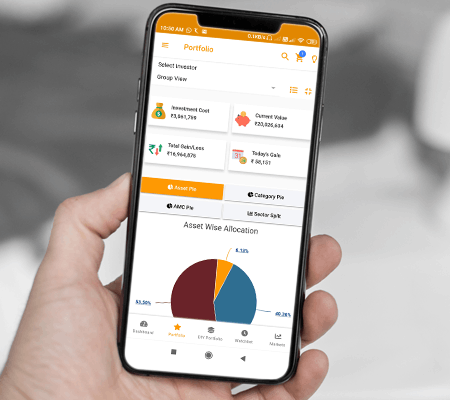Heading will come here
View Now- ICICI Prudential Advisor Series - Dynamic Accrual Plan 31.85 0.00(0.00%)
|
10,195.15 10.2600 (-3.3%) 16-03-2018 12:00 |
Prev Close 10,360.15 | Open 10,345.15 | High 10,346.30 | Low 10,180.25 | Details |
| NSE: Asian Paints | BSE: 500820 | Sector: Chemicals |
|
NSE Mar 16 2018, 4:01 1,160.80 23.90(+3.90%) |
BSE Mar 16 2018, 4:01 2,260.90 23.90(+3.90%) |
View Details |
Invest Guide April 2023
CEO's Desk
Dear Investors,
Indian equity markets after touching their peaks in December 2022, turned weaker due to various market worries - US Fed's hike of interest rates, concerns about Adani Group companies due to Hindenburg report, Russia's nuclear rhetoric and US banking crisis.
The key benchmark indices viz. S&P BSE Sensex & CNX Nifty corrected by 3% and 4% respectively during the Jan-Mar quarter. The mid and small-cap indices fell sharper than their larger peers with the S&P BSE Mid-cap and S&P BSE Small-cap indices losing around 5% and 7% respectively during the quarter.
Among sectoral indices BSE Capital Goods and BSE FMCG were top performers while BSE Power and BSE Oil & Gas were laggards during the quarter.

India's retail inflation, which is measured by the Consumer Price Index (CPI), declined marginally to 6.44 per cent year-on-year in February as against 6.52 per cent in January. The inflation rate has remained above the Reserve Bank of India's (RBI) tolerance band of 2-6 per cent for the second straight month.
In order to contain inflation, the RBI has increased Repo rate by 250 basis points, from 4% to 6.5% since May 2022. RBI may hike policy rate by 25 bps further in its next MPC meeting in April, followed by a prolonged wait-and-watch approach.
The S&P Global Composite Purchasing Managers' Index (PMI) was at 59.0 in February, up from January's 57.5 and above its long-term average. Meanwhile, the S&P Global India Services Purchasing Managers' Index rose from 57.2 in January to 59.4 in February, its highest since February 2011. The seasonally adjusted S&P Global India Manufacturing Purchasing Managers' Index (PMI) was at 55.3 in February, little-changed from 55.4 in January.
India's current account deficit (CAD) has dropped sharply to $18.2 billion in the October-December period. At $18.2 billion, CAD for the last quarter of CY2022 is sharply lower than July-September's revised figure of $30.9 billion. For April-December 2022, the current account deficit was $67.0 billion compared to $25.3 billion in April-December 2021. In percentage terms, the CAD for the first three quarters of 2022-23 is 2.7 percent of GDP as against 1.1 percent in April-December 2021.
The government's fiscal deficit for the first 11 months of 2022-23 widened to Rs 14.54 lakh crore. At Rs 14.54 lakh crore, the fiscal deficit for April 2022-February 2023 accounted for 82.8 percent of the full-year target for 2022-23. Fiscal deficit in the first 11 months of the last financial year was 82.7 percent of that year's target. On the receipts side, gross tax revenues were up by 12 percent in April-February, although the growth exhibited in February was just 4.5 percent.
The 10-year Government bond yield has ended the Jan-Mar quarter at 7.315%, down by 2 basis points from the previous quarter due to collapse of two regional banks in the US. We feel that in view of the sudden failure of two regional banks in the US along with turmoil in a large European bank, addressing financial stability risks has become a high priority (instead of focusing on inflation only) and a key factor for future monetary policy actions for global central banks. The events have unexpectedly changed the outlook for Fed's interest rate path. The earlier probability of US Fed fund rate peaking at 5.5-5.75% and staying there for entire CY23 has now changed to possibility of rate cuts over the next 6 to 12 months.
In India too, we are near the end of the rising interest rate cycle now. Inflation is likely to be eased in the coming months and hence, RBI may not increase rates significantly beyond the current levels.
India's GDP growth slowed sequentially to 4.4% in Q3FY23, compared with 6.3% growth in Q2FY23. India's GDP, although moderated sequentially, stands strong amongst select Developed & Emerging Economies. However, declining exports have undertone of global economic slowdown. As per RBI, India is projected to grow at 6.4% in FY24. RBI has projected first quarter growth at 7.8%, second quarter growth at 6.2%, third quarter growth at 6%, and fourth quarter growth at 5.8% in FY24.
In terms of valuation, equity markets are currently trading at 17x 1 year forward earnings which are not expensive in wake of macroeconomic stability, relatively resilient EPS growth and a conducive flow environment. We expect manufacturing push, improving credit growth and rural recovery to provide major boost to the economy and earnings growth.
We feel that for equity investors it is time to start to accumulate equities in a staggered manner as valuations have become reasonable now after the last 18 months of market consolidation and earnings momentum is likely to see a revival going ahead. Therefore, medium term outlook for Indian equities looks good as there are many drivers that are shaping India's economic ascent in the coming years - Digital competitiveness, diversification of global supply chains away from China, PLI-like incentives for the development of a dominant manufacturing base, focus on public infrastructure investment and stable political environment. Having said that, markets may be volatile in the near term due to global macroeconomic and geopolitical uncertainties.
We feel that major triggers for the markets could be the US Fed & RBI policy guidance, global flows and domestic & global growth data. For Indian investors, the policy stance of both the RBI and the US Fed needs to be watched as a rise in spread between US and Indian treasuries could attract FIIs to Indian assets and vice versa.
































